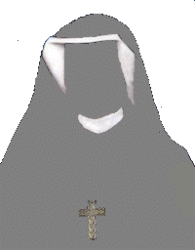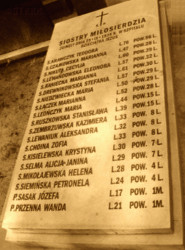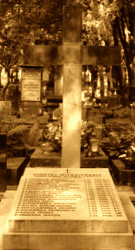Roman Catholic
St Sigismund parish
05-507 Słomczyn
85 Wiślana Str.
Konstancin deanery
Warsaw archdiocese, Poland
full list:
displayClick to display full list

searchClick to search full list by categories
wyświetlKliknij by wyświetlić pełną listę po polsku

szukajKliknij by przeszukać listę wg kategorii po polsku

Martyrology of the clergy — Poland
XX century (1914 – 1989)
personal data

surname
DREWNIKOWSKA
forename(s)
Stephanie (pl. Stefania)
function
nun
creed
Latin (Roman Catholic) Church RCmore on
en.wikipedia.org
[access: 2014.09.21]
congregation
Congregation of the Daughters of Charity of Saint Vincent de Paul FdlCmore on
en.wikipedia.org
[access: 2013.05.19]
(i.e. Daughters of Charity)
date and place
of death
25.09.1939

Warsawtoday: Warsaw city pov., Masovia voiv., Poland
more on
en.wikipedia.org
[access: 2021.10.09]
details of death
After German and Russian invasion of Poland in 09.1939 and start of the World War II, during Warsaw siege and aerial bombardment of the city by the Germans known as „Black Monday”, died while ministering in the Baby Jesus hospital.
During the siege prob. ministered as a nurse and, while supporting the fighting and wounded, perished.
cause of death
mass murder
perpetrators
Germans
sites and events
Warsaw (Black Monday)Click to display the description, Air raids 1939Click to display the description, Ribbentrop‐MolotovClick to display the description, Pius XI's encyclicalsClick to display the description
date and place
of birth
26.08.1889

Gościeradówtoday: Gościeradów‐Folwark, Gościeradów gm., Kraśnik pov., Lublin voiv., Poland
more on
en.wikipedia.org
[access: 2021.09.29]
alt. dates and places
of birth
1892,1899
parents
DREWNIKOWSKI Stanislav
🞲 ?, ? — 🕆 ?, ?

Angela
🞲 ?, ? — 🕆 ?, ?
positions held
till 1939
nun — Warsawtoday: Warsaw city pov., Masovia voiv., Poland
more on
en.wikipedia.org
[access: 2021.10.09] ⋄ Congregation's house (by the Baby Jesus hospital, 4 Lindleya Str.), Daughters of Charity FdlC — nurse
c. 1910
accession — Daughters of Charity FdlC
others related
in death
BIAŁAClick to display biography Anne Praxedes (Sr Adolphine), CHOINAClick to display biography Sophia, CZAJKOWSKAClick to display biography Marianne Casimira, CZYMEKClick to display biography Charles, GĄSIOROWSKIClick to display biography Francis, GRZEGORCZYKClick to display biography Francis (Bro. Thaddeus), HATKOClick to display biography Francis (Fr Matthew), KACZMAREKClick to display biography Josefa (Sr Andrea), KISIELEWSKAClick to display biography Christine Irene, KRAWCZYKClick to display biography Theodosia, LANGERClick to display biography John, LEOŃCZUKClick to display biography Marianne, LEWANDOWSKAClick to display biography Eleonor, LEWANIUKClick to display biography Aleksandra, ŁĄCZEKClick to display biography Marianne, MIKOŁAJEWSKAClick to display biography Helen, NIEDŹWIECKAClick to display biography Marianne, NIKUTAClick to display biography Cecilia Aleksandra, OPIELAClick to display biography Joseph, OSTROWSKIClick to display biography Stanislav Kostka Chris Alexander (Fr Josaphat), PSZENNAClick to display biography Wanda, RANIECKAClick to display biography Mary Agatha, RUSZKOWSKAClick to display biography Stanislava, SASAKClick to display biography Josefa Aleksandra, SELMAClick to display biography Alice Janet, SIEMIŃSKAClick to display biography Petronella, TEODOROWICZClick to display biography Terrence, WÓJCIKClick to display biography Marianne, ZEMBRZUSKAClick to display biography Casimira
sites and events
descriptions
Warsaw (Black Monday): German Germ. Luftwaffe (Eng. Air Force) the first air raids on Warsaw — attacking, among others, Warsaw housing estates — carried out on the first day of the war, 01.09.1939. The first major German assault on the capital on 08.09.1939 was repelled. On 17.09.1939, over 5,000 artillery shells and aircraft bombs fell on the city. On 22.09.1939, the German encirclement ring closed around Warsaw. On 25.09.1939 from 7:00 till late evening more than 400 German bombers made aerial raids on Warsaw. Almost 630 tons of explosives, both incendiary and demolishing were dropped. Caused c. 200 fires. Public building were not spared, including hospitals clearly marked with Red Cross signs (in fact they were targeted in the first place). Holy Ghost hospital was among them and c. 700 people, both patients and staff were killed (including 20 Vincentian sisters). Altogether during those saturation raids called „Black Monday” c. 10,000 people perished, 35,000 were wounded, mostly civilian. The raids were in contravention of Hague agreements and must be regarded as an act of war crime. (more on: pl.wikipedia.orgClick to attempt to display webpage
[access: 2015.04.18])
Air raids 1939: During invasion of Poland commenced on 01.09.1939 Germans systematically attacked civilian targets. Many cities (Wieluń, Frampol, Warszawa, Lwów, Łomża, Puck, etc.) were bombed during air raids and totally destroyed. The hospitals and churches, visibly marked as such, were not spared. German planes also attacked columns of fleeing people on the roads, massacring them. It is estimated that c. 150,000‐200,000 civilians were killed or murdered by the Germans in 09.1939. (more on: en.wikipedia.orgClick to attempt to display webpage
[access: 2015.04.18])
Ribbentrop‐Molotov: Genocidal Russian‐German alliance pact between Russian leader Joseph Stalin and German leader Adolf Hitler signed on 23.08.1939 in Moscow by respective foreign ministers, Mr. Vyacheslav Molotov for Russia and Joachim von Ribbentrop for Germany. The pact sanctioned and was the direct cause of joint Russian and German invasion of Poland and the outbreak of the World War II in 09.1939. In a political sense, the pact was an attempt to restore the status quo ante before 1914, with one exception, namely the „commercial” exchange of the so‐called „Kingdom of Poland”, which in 1914 was part of the Russian Empire, fore Eastern Galicia (today's western Ukraine), in 1914 belonging to the Austro‐Hungarian Empire. Galicia, including Lviv, was to be taken over by the Russians, the „Kingdom of Poland” — under the name of the General Governorate — Germany. The resultant „war was one of the greatest calamities and dramas of humanity in history, for two atheistic and anti‐Christian ideologies — national and international socialism — rejected God and His fifth Decalogue commandment: Thou shall not kill!” (Abp Stanislav Gądecki, 01.09.2019). The decisions taken — backed up by the betrayal of the formal allies of Poland, France and Germany, which on 12.09.1939, at a joint conference in Abbeville, decided not to provide aid to attacked Poland and not to take military action against Germany (a clear breach of treaty obligations with Poland) — were on 28.09.1939 slightly altered and made more precise when a treaty on „German‐Russian boundaries and friendship” was agreed by the same murderous signatories. One of its findings was establishment of spheres of influence in Central and Eastern Europe and in consequence IV partition of Poland. In one of its secret annexes agreed, that: „the Signatories will not tolerate on its respective territories any Polish propaganda that affects the territory of the other Side. On their respective territories they will suppress all such propaganda and inform each other of the measures taken to accomplish it”. The agreements resulted in a series of meeting between two genocidal organization representing both sides — German Gestapo and Russian NKVD when coordination of efforts to exterminate Polish intelligentsia and Polish leading classes (in Germany called «Intelligenzaktion», in Russia took the form of Katyń massacres) where discussed. Resulted in deaths of hundreds of thousands of Polish intelligentsia, including thousands of priests presented here, and tens of millions of ordinary people,. The results of this Russian‐German pact lasted till 1989 and are still in evidence even today. (more on: en.wikipedia.orgClick to attempt to display webpage
[access: 2015.09.30])
Pius XI's encyclicals: Facing the creation of two totalitarian systems in Europe, which seemed to compete with each other, though there were more similarities than contradictions between them, Pope Pius XI issued in 03.1937 (within 5 days) two encyclicals. In the „Mit brennender Sorge” (Eng. „With Burning Concern”) published on 14.03.1938, condemned the national socialism prevailing in Germany. The Pope wrote: „Whoever, following the old Germanic‐pre‐Christian beliefs, puts various impersonal fate in the place of a personal God, denies the wisdom of God and Providence […], whoever exalts earthly values: race or nation, or state, or state system, representatives of state power or other fundamental values of human society, […] and makes them the highest standard of all values, including religious ones, and idolizes them, this one […] is far from true faith in God and from a worldview corresponding to such faith”. On 19.03.1937, published „Divini Redemptoris” (Eng. „Divine Redeemer”), in which criticized Russian communism, dialectical materialism and the class struggle theory. The Pope wrote: „Communism deprives man of freedom, and therefore the spiritual basis of all life norms. It deprives the human person of all his dignity and any moral support with which he could resist the onslaught of blind passions […] This is the new gospel that Bolshevik and godless communism preaches as a message of salvation and redemption of humanity”… Pius XI demanded that the established human law be subjected to the natural law of God , recommended the implementation of the ideal of a Christian state and society, and called on Catholics to resist. Two years later, National Socialist Germany and Communist Russia came together and started World War II. (more on: www.vatican.vaClick to attempt to display webpage
[access: 2023.05.28], www.vatican.vaClick to attempt to display webpage
[access: 2023.05.28])
sources
personal:
straty.plClick to attempt to display webpage
[access: 2021.12.18], niezapomnijonas.plClick to attempt to display webpage
[access: 2024.03.19]
bibliographical:
„Martyrology of the Polish Roman Catholic clergy under nazi occupation in 1939‐1945”, Victor Jacewicz, John Woś, vol. I‐V, Warsaw Theological Academy, 1977‐1981
„A martyrology of Polish clergy under German occupation, 1939‐1945”, Fr Szołdrski Vladislaus CSSR, Rome 1965
original images:
cmentarze.um.warszawa.plClick to attempt to display webpage
[access: 2015.05.09], cmentarze.um.warszawa.plClick to attempt to display webpage
[access: 2015.05.09]
LETTER to CUSTODIAN/ADMINISTRATOR
If you have an Email client on your communicator/computer — such as Mozilla Thunderbird, Windows Mail or Microsoft Outlook, described at WikipediaPatrz:
en.wikipedia.org, among others — try the link below, please:
LETTER to CUSTODIAN/ADMINISTRATORClick and try to call your own Email client
If however you do not run such a client or the above link is not active please send an email to the Custodian/Administrator using your account — in your customary email/correspondence engine — at the following address:

giving the following as the subject:
MARTYROLOGY: DREWNIKOWSKA Stephanie
To return to the biography press below:
 Click to return to biography
Click to return to biography









